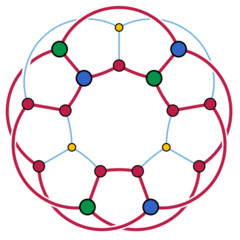Kuratowski's theorem

In graph theory, Kuratowski's theorem is a mathematical forbidden graph characterization of planar graphs, named after Kazimierz Kuratowski. It states that a finite graph is planar if and only if it does not contain a subgraph that is a subdivision of [math]\displaystyle{ K_5 }[/math] (the complete graph on five vertices) or of [math]\displaystyle{ K_{3,3} }[/math] (a complete bipartite graph on six vertices, three of which connect to each of the other three, also known as the utility graph).
Statement
A planar graph is a graph whose vertices can be represented by points in the Euclidean plane, and whose edges can be represented by simple curves in the same plane connecting the points representing their endpoints, such that no two curves intersect except at a common endpoint. Planar graphs are often drawn with straight line segments representing their edges, but by Fáry's theorem this makes no difference to their graph-theoretic characterization.
A subdivision of a graph is a graph formed by subdividing its edges into paths of one or more edges. Kuratowski's theorem states that a finite graph [math]\displaystyle{ G }[/math] is planar if it is not possible to subdivide the edges of [math]\displaystyle{ K_5 }[/math] or [math]\displaystyle{ K_{3,3} }[/math], and then possibly add additional edges and vertices, to form a graph isomorphic to [math]\displaystyle{ G }[/math]. Equivalently, a finite graph is planar if and only if it does not contain a subgraph that is homeomorphic to [math]\displaystyle{ K_5 }[/math] or [math]\displaystyle{ K_{3,3} }[/math].
Kuratowski subgraphs
If [math]\displaystyle{ G }[/math] is a graph that contains a subgraph [math]\displaystyle{ H }[/math] that is a subdivision of [math]\displaystyle{ K_5 }[/math] or [math]\displaystyle{ K_{3,3} }[/math], then [math]\displaystyle{ H }[/math] is known as a Kuratowski subgraph of [math]\displaystyle{ G }[/math].[1] With this notation, Kuratowski's theorem can be expressed succinctly: a graph is planar if and only if it does not have a Kuratowski subgraph.
The two graphs [math]\displaystyle{ K_5 }[/math] and [math]\displaystyle{ K_{3,3} }[/math] are nonplanar, as may be shown either by a case analysis or an argument involving Euler's formula. Additionally, subdividing a graph cannot turn a nonplanar graph into a planar graph: if a subdivision of a graph [math]\displaystyle{ G }[/math] has a planar drawing, the paths of the subdivision form curves that may be used to represent the edges of [math]\displaystyle{ G }[/math] itself. Therefore, a graph that contains a Kuratowski subgraph cannot be planar. The more difficult direction in proving Kuratowski's theorem is to show that, if a graph is nonplanar, it must contain a Kuratowski subgraph.
Algorithmic implications
A Kuratowski subgraph of a nonplanar graph can be found in linear time, as measured by the size of the input graph.[2] This allows the correctness of a planarity testing algorithm to be verified for nonplanar inputs, as it is straightforward to test whether a given subgraph is or is not a Kuratowski subgraph.[3] Usually, non-planar graphs contain a large number of Kuratowski-subgraphs. The extraction of these subgraphs is needed, e.g., in branch and cut algorithms for crossing minimization. It is possible to extract a large number of Kuratowski subgraphs in time dependent on their total size.[4]
History
Kazimierz Kuratowski published his theorem in 1930.[5] The theorem was independently proved by Orrin Frink and Paul Smith, also in 1930,[6] but their proof was never published. The special case of cubic planar graphs (for which the only minimal forbidden subgraph is [math]\displaystyle{ K_{3,3} }[/math]) was also independently proved by Karl Menger in 1930.[7] Since then, several new proofs of the theorem have been discovered.[8]
In the Soviet Union, Kuratowski's theorem was known as either the Pontryagin–Kuratowski theorem or the Kuratowski–Pontryagin theorem,[9] as the theorem was reportedly proved independently by Lev Pontryagin around 1927.[10] However, as Pontryagin never published his proof, this usage has not spread to other places.[11]
Related results
A closely related result, Wagner's theorem, characterizes the planar graphs by their minors in terms of the same two forbidden graphs [math]\displaystyle{ K_5 }[/math] and [math]\displaystyle{ K_{3,3} }[/math]. Every Kuratowski subgraph is a special case of a minor of the same type, and while the reverse is not true, it is not difficult to find a Kuratowski subgraph (of one type or the other) from one of these two forbidden minors; therefore, these two theorems are equivalent.[12]
An extension is the Robertson–Seymour theorem.
See also
- Kelmans–Seymour conjecture, that 5-connected nonplanar graphs contain a subdivision of [math]\displaystyle{ K_5 }[/math]
References
- ↑ "How to draw a graph", Proceedings of the London Mathematical Society, Third Series 13: 743–767, 1963, doi:10.1112/plms/s3-13.1.743.
- ↑ Williamson, S. G. (September 1984), "Depth-first search and Kuratowski subgraphs", J. ACM 31 (4): 681–693, doi:10.1145/1634.322451.
- ↑ Mehlhorn, Kurt; Näher, Stefan (1999), LEDA: A Platform for Combinatorial and Geometric Computing, Cambridge University Press, p. 510, ISBN 9780521563291, https://books.google.com/books?id=Q2aXZl3fgvMC&pg=PA510.
- ↑ Chimani, Markus (2007), "Efficient extraction of multiple Kuratowski subdivisions", Graph Drawing: 15th International Symposium, GD 2007, Sydney, Australia, September 24-26, 2007, Revised Papers, Lecture Notes in Computer Science, 4875, Springer, pp. 159–170, doi:10.1007/978-3-540-77537-9_17, ISBN 978-3-540-77536-2
- ↑ Kuratowski, Kazimierz (1930), "Sur le problème des courbes gauches en topologie" (in French), Fund. Math. 15: 271–283, doi:10.4064/fm-15-1-271-283, http://matwbn.icm.edu.pl/ksiazki/fm/fm15/fm15126.pdf.
- ↑ "Irreducible non-planar graphs", Bulletin of the AMS 36: 214, 1930
- ↑ "Über plättbare Dreiergraphen und Potenzen nichtplättbarer Graphen", Anzeiger der Akademie der Wissenschaften in Wien 67: 85–86, 1930
- ↑ "Kuratowski's theorem", Journal of Graph Theory 5 (3): 225–241, 1981, doi:10.1002/jgt.3190050304.
- ↑ Burstein, Michael (1978), "Kuratowski-Pontrjagin theorem on planar graphs", Journal of Combinatorial Theory, Series B 24 (2): 228–232, doi:10.1016/0095-8956(78)90024-2
- ↑ Kennedy, John W.; Quintas, Louis V.; Sysło, Maciej M. (1985), "The theorem on planar graphs", Historia Mathematica 12 (4): 356–368, doi:10.1016/0315-0860(85)90045-X
- ↑ Chartrand, Gary; Lesniak, Linda; Zhang, Ping (2010), Graphs & Digraphs (5th ed.), CRC Press, p. 237, ISBN 9781439826270, https://books.google.com/books?id=K6-FvXRlKsQC&pg=PA237.
- ↑ Bondy, J. A.; Murty, U.S.R. (2008), Graph Theory, Graduate Texts in Mathematics, 244, Springer, p. 269, ISBN 9781846289699, https://books.google.com/books?id=HuDFMwZOwcsC&pg=PA269.
 |

